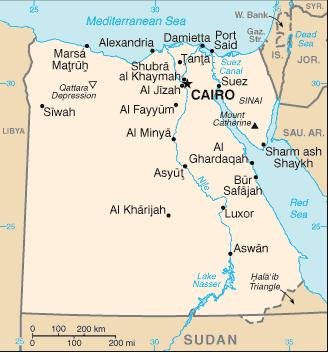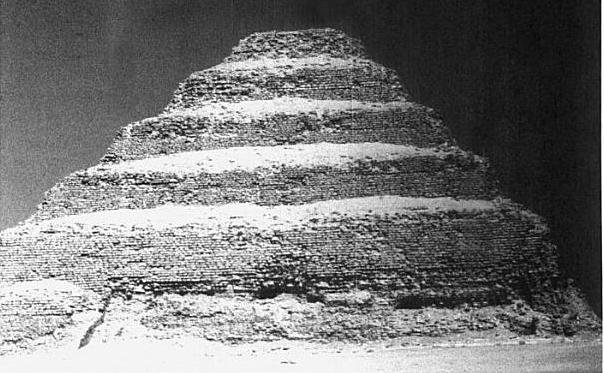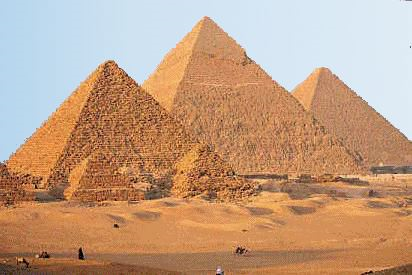Introduction
While the human race takes great pride in the progressive nature of each subsequent civilization, there exist objects from past civilizations that are hailed as marvels in the civilization process. While some of this objects gain their prominence primarily due to their old age, others are distinct due to their magnitude and the sheer artistry which led to their creation. The great pyramids of Egypt fall under the second category and these structures have continued to fascinate man as a result of the ingenuity with which they were created.
Explorers from Europe made their way to Egypt to witness this great architectural wonders and as far back as 1842, the Prusian explorer, Karl Richard Lepsius conducted expeditions to Egypt and set out to document the number of pyramids that the North African country boasted (Lacovara 30). Over the years, pyramids of Egypt have continued to fascinate modern man the great structures are indeed revered as one of the great wonders of the ancient world.
Owing to the great interest that pyramids elicit from man as well as the ancient cultural knowledge concerning ancient Egyptians that they give, it would be a worthwhile endeavor to carry out a study into these ancient structures. To this end, this paper shall set out to investigate the pyramids of Egypt with the aim of presenting an informative paper about the same.
Their present locations as well as their physical attributes shall be given. Some of the most plausible theories as to their construction shall also be mentioned. A look at the significance of the pyramids to the ancient Egyptian people shall also be made so as to enable us to have a better appreciation of these magnificent structures.
Egypt: Site of the Pyramids
Egypt is an African country that exists on the Northern part of the continent bordering the Mediterranean Sea (CIA). The country consists mostly of desert landscape with the exception of the Nile Valley which is very fertile and provides for most of the agricultural and water needs of the country.
While the presence of the Suez Canal (a waterway which serves as a link between the Mediterranean Sea and the Indian Ocean) gives Egypt some amount of prominence due to its strategic geographical positioning, it is the pyramids that have made the country famous all over the world. Despite the fact that many other ancient civilizations built pyramids which served as temples or tombs, the pyramids of Egypt are by far the most magnificent and well renowned.

Fig. 1. The Map of Egypt from the Central Intelligence Agency World FactBook. Cia.gov: June. 24 2010. Web..
In the earlier years, the ancient pyramid sites were constantly attacked by treasure hunters who engaged in uncontrolled pillaging of the sites looting off invaluable ancient artifacts (Lacovara 30). Some of the previous Egyptians are also known to have turned the sites of pyramids into quarries to provide stones for building settlements.
However, as a result of the discovery of the great value that the pyramids had by both archaeologists and historians, there arose need to create means by which this sites could be safeguarded from destruction. The National Antiquities Service was therefore created to oversee archaeological works in the pyramids as a result of the great interest in Egypt’s pyramids and by extension its ancient past (Lecovara 30).
This led to the restoration of some of the greatest pyramid sites and the discovery of great treasures which are now found in Egyptian museums. This was not only a culturally motivated move but also an economic one since at present, Egypt’s pyramids attract hundreds of thousands of tourists into the country each year making a significant contribution to the country’s annual GDP.
The Development of Pyramids
Ancient Egyptian religion taught that earthly life was followed by an afterlife and the transition from the world of the living to that of the dead held a special place in Egyptian culture.
The preservation of the dead body of an important person was seen as mandatory least the spirit of the said person wonders off unsatisfied bringing great disaster to the living. For this reason the mummification process, which was aimed at preserving the body of the dead, as well as building of durable tombs was practiced by Egyptians (Moffet, Fazio and Wodehouse 123).
At the onset, dead pharaohs were buried in tombs known as Mastabas. These tombs were built of durable material unlike the houses that the Egyptians lived in which were made of reed, wood and other easily decomposable material. Physically, Mastabas were rectangular blocks made of baked clay and in later years, stones. It is these Mastabas that were enlarged to form a pyramid by stacking them one on top of each other.
The religious basis of the pyramids cannot be overstated and as Moffett, Fazio and Wodehouse document, “the pyramid, an upward-stepping form whose peak caught the first rays of morning light, was the emblem of the sun god as worshiped at Heliopolis” (123). Rosalie further notes that the Egyptian pyramids were meant to provide a comfortable afterlife for the deceased and they were therefore built of stone since they were meant to last for eternity (3).
The building of the Pyramids
Historians generally agree that construction of the pyramids were commissioned by the rules of the land (Pharaoh’s) in a time of great prosperity in Egypt. However, there exists a popular misconception that the Egyptian pyramids were build through the use of slave labor. This misconception is further reinforced by popular myths advanced which propose that the Jewish slaves who are known to have labored in Egypt under pharaoh’s rule constructed these huge structures.
Malek and Forman reveal that the construction workers of the pyramids were Egyptians who were not only loyal subjects to the pharaoh but also took great pride in their role in the building of these monumental structures (74). Archaeological findings around the pyramid sites also reinforce this claim since they reveal that the builders who made settlements near the construction sites were of native Egyptian origin.
Furthermore, the burial grounds situated near the pyramids reveal the tombs of actual builders which were constructed in true and proper Egyptian tradition. Ruiz declares that this is conclusive evidence that Egyptians formed the labor force in the pyramid construction since slaves were not given Egyptian burials even if they died in the country (217).
Imhotep (the chief architect of pharaoh Djoser who reigned from2630 – 2611 BC) is credited with designing the first pyramid (Moffett, Fazio and Wodehouse 125). In the construction of a Pyramid, the pyramids were not built as individual structures but rather as part of a massive complex.
However, the pyramids formed the centerpiece of the entire construction and where made of more durable material since they were intended to last forever. The pyramids which started off as a compilation of Mastabas were built to attain their present shape and mass and later finished by dressing them with limestone. The pyramids were generally made of limestone although some parts of the interior were made of black granite which was imported from neighboring lands (Malek and Forman 58).
One of the issues that continue to puzzle modern man is how the ancient Egyptians were able to constructs these huge pyramids without the aid of modern machinery such as cranes which would have been used to carry the huge stone blocks as they ascended up to the top of the pyramid.
While no record providing information as to how the planning, design and subsequent construction of the pyramids took place, there exist remains of ramps build from mud that offer some insight into how the construction process took place. Ruiz theorizes that a ramp would have led from ground level to the top of the first layer of stone and a second ramp would have led to the next level progressively (217).
Once the gigantic piles of stone had reached the apex, the workers worked their way down smoothing off the outer blocks as well as removing the ramps. Limestone was then used as finishing giving the pyramid a shiny finish which could be seen from miles away (Ruiz 217). However, most of the outer finishing was removed by future civilizations which used it as building material and hence the stony outlook that pyramids have at present.
Another Issue in relation to the construction of the pyramids is with regard to how the huge blocks of stones (averaging 2 tons in weight) used for the pyramid construction were transported from the quarries up to the site of the pyramids. This mystery is unraveled by Malek and Forman who propose that the pyramids were built in the seasons when the great Nile had flooded (74). This meant that the builders were able to transport building material and in particular the heavy stones by floating on the flooded river basin.
The Pyramids of Egypt
It is estimated that Egypt boasts of around 138 pyramids which are found at various locations in the country. These pyramids vary in size as well as in the degree to which they have deteriorated with time. The oldest pyramid is the Pyramid of Djoser which is located outside of Memphis.
This pyramid was designed by the architect Imhotep and it was the first monumental construction in stone made by the Egyptians (O’Donnell 125). This stepped pyramid rises to 197 feet above ground and has a 397 by 358 foot base. While it is not the most outstanding of the Egyptian pyramids, it is the oldest one and is said to have begun as a mastaba with the pyramid being build in several stages until it attained its present shape and mass.

Fig. 2. The Step Pyramid of Djoser from Baker, Rosalie and Baker Charles
Of all the pyramids constructed by the ancient Egyptians, the most majestic ones are those that are found in Giza. These three large pyramids of Giza were the work of three pharaohs; Khufu, Khafre and Menkaure. The three pyramids are said to have been constructed between 2550BC and 2460BC.
The Greatest amongst these pyramids is the pyramid of Khufu who reigned 2551-2528BC. This pyramid covers a 755 by 755 foot base and it rises to an astonishing height of 481 feet at its apex (Moffett, Fazio and Wodehouse 143). For this reason, the Giza pyramid site is the most attractive one to tourists and was allegedly built at the time of highest prosperity by the pharaohs.

Fig. 3. The Three Pyramids at Giza. cap.nsw.edu: Web.
Cultural Significance of the Pyramids
On their construction, the pyramids were intended to last for eternity. For this reason, the most durable material of that time (stone) was utilized and great measures undertaken to make the structures as stable as was possible.
While the ancients may have been overambitious in their vision of an everlasting physical structure, their ingenuity has withstood the test of time with the oldest pyramid being estimated to have been in existence for the past 4600 years. These structures have offered great insights into the lives of this ancient civilization and the archaeological findings from these sites have added to our knowledge of ancient Egyptian culture.
One of the aspects of ancient Egypt which the pyramids offer insight into is that of the religious believes of the ancient Egyptian people. The knowledge of Egyptian religion is based on the papyrus scrolls that have been found in the tombs contained in pyramids. It is said that this religious material were placed with the dead to provide them with details of the next world and give them instructions on how to get there (Grant, Gorin and Flemin 190).
An exploration into the pyramids shows various wall paintings which reveal a lot about the ancient Egyptian’s beliefs. Grand, Gorin and Fleming demonstrate that by wall painting depicting people with faces of birds, one can infer that early Egyptian deities were zoomorphic who used animals to represent particular manifestations of gods (190).
The significance the pharaohs held in the Egyptian society can also be inferred from the pyramids. There exist prayers carved into the walls of pyramid chambers that make reference to stars and to the accent of pharaoh’s into the sky to be among them. Rosalie affirms that pyramids indeed were used for official religion and the pyramid temple played an important part in the burial of the king and thereafter became a site where the priesthood performed daily rituals so as to minister to the spirit of the dead king (131).
In addition to this, pyramids also played an important role in the lives of the living people. It was at the steps of the pyramids that divinations by priests and priestesses of the gods were made and the burial rituals of people were preceded over. Major ceremonies were also undertaken at the foot of the pyramids which were revered as religious icons.
Conclusion
This paper set out to give a detailed discussion of one of the world’s greatest archeological sites, the Egyptian pyramids. The paper began by providing a brief overview of the country Egypt so as to highlight the significance of the pyramids to the modern Egyptian people. The ancient practices and beliefs which led to the creation of the pyramids have also been discussed and the wonder of how such a great feat of architecture was achieved theorized.
While it has been noted that there do exist many theories as to how the pyramids were constructed, there is general agreement that this structures are truly a marvel of the ancient human civilization. The cultural value that the pyramids provide modern man with cannot be quantified for the pyramids acted as a sanctuary to a myriad of objects that offer us a glimpse into ancient civilization. Therefore, from the findings in these pyramids, modern man is able to understand and therefore better appreciate his predecessors.
Works Cited
Baker, Rosalie and Baker, Charles. Ancient Egyptians: People of the Pyramids. USA: Oxford University Press US, 2001.
Central Intelligence Agency. The World Factbook – Egypt. 24 June. 2010. Web. https://www.cia.gov/the-world-factbook/countries/egypt/
Grant, Jim. Gorin, Sam and Fleming Neil. The Archaeology Coursebook: An Introduction to Themes, Sites, Methods and Skills. Taylor & Francis, 2008.
Malek, Jaromir and Forman, Werner. In the Shadow of the Pyramids: Egypt During the Old Kingdom. Editorial Galaxia, 1986.
Moffet, Marian. Fazio, Michael and Wodehouse, Lawrence. A World History of Architecture. Laurence King Publishing, 2003.
O’Donnell, Kerri. The Pyramids of Egypt. NY: The ROsen Publishing Group, 2003.
Rosalie, David. The Pyramid Builders of Ancient Egypt: A Modern Investigation of Pharaoh’s Workforce. Taylor & Francis, 2003.
Ruiz, Ana. The Spirit of Ancient Egypt. Algora Publishing, 2001.